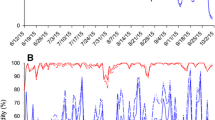Abstract
Protecting vegetables with a screen in peri-urban areas of tropical countries could reduce or even prevent often indiscriminate insecticide applications by small-scale farmers. The advantages of such an approach are protection of human health by reducing insecticide sprays, reducing environmental pollution from insecticide residues and increasing effectiveness of crop protection. Tunnel screens are well adapted to farmers cultivating intensively on small plots. Two trials were conducted to test the ability of screened tunnels to protect Brassica oleracea crops. The first was carried out on-station and the second in partnership with three farmers in Cotonou, Benin, West Africa. Tunnel screens impregnated with deltamethrin were found to be particularly well adapted to protect young plants in seedling nurseries against infestations by the aphid Lipaphis erysimi (Kaltenbach). The number of diamondback moth Plutella xylostella (Linnaeus) and borer Hellula undalis (Fabricius) on cabbages protected with the tunnel screen was significantly lower than that of plots conventionally treated with insecticides. The tunnel screen was not efficient against the armyworm Spodoptera littoralis (Boisduval) which laid eggs on the screen. After planting out, the use of a temporary screen from 1700 to 0900h gave better control against pests than the use of a permanent screen possibly due to the impact of natural enemies during the day. The field trials showed that the protection of cabbage with a tunnel screen could be an economically viable method. The costs of pesticides are on average US$ 45 per 100 m2 for one crop cycle compared with US$ 24 per100 m2 for tunnel screen material (assuming that this material can be used for 10 consecutive crop cycles). In addition, there are environmental benefits from a reduction of pesticide use. Farmers will have to cope with the initial investment for the screen material, which is, however, very cost-effective and locally available. Tunnel screens for vegetable protection can be easily combined with other integrated pest-management techniques.
Similar content being viewed by others
References
Agossou G., Ahouansou T., Aly D. and Assogba-Komlan F. (2001) Etude sur la promotion de la filiere des cultures maraîchères au Bénin. Internal Report, Ministere de l’Agriculture de l’Elevage et de la Peche, Cotonou, Benin. 89 pp.
Assogba-Komlan F., Singbo A. and Adegbola Y. P. (2002) Agriculture Urbaine au Benin: Cas de la ville de Cotonou. Internal Report, Ministère de l’Agriculture de l’Elevage et de la Pêche, Cotonou, Bénin. 30 pp.
Dinham B. (2003) Growing vegetables in developing countries for local urban populations and export markets: problems confronting small-scale producers. Pest Management Science 59, 575–582.
Goudegnon E. A., Kirk A. A., Schiffers B. and Bordat D. (1998) Comparative effects of deltamethrin and neem kernel to Plutella xylostella and Cotesia plutellae populations in Cotonou peri-urban area (Benin). Journal of Applied Entomology 124, 141–144.
James B., Atcha C., Godonou I. and Baimey H. (2005) Healthy vegetables through participatory IPM in periurban areas of Benin. Technical Report IITA, June. 49 pp.
MAEP (2005) Arrêtés du Ministère de l’Agriculture, de l’Elevage et de la Pêche, portant renouvellement d’agrément des produits phytopharmaceutiques au Bénin. N°2152 et 2153/MAEP/DCAB/SGM/DRH/DAGRI/SA. Ministère de l’Agriculture, de l’Elevage et de la Pêche, Bénin.
Martin T., Chandre F., Ochou Ochou G., Vaissayre M. and Fournier D. (2002) Pyrethroid resistance mechanisms in the cotton bollworn Helicoverpa armigera (Lepidoptera: Noctuidae) from West Africa. Pesticide Biochemistry and Physiology 74, 17–26.
Martin T., Assogba-Komlan F., Houndete T., Hougard J. M. and Chandre F. (2006) Efficacy of mosquito netting for sustainable small holders’ cabbage production in Africa. Journal of Economic Entomology 99, 450–454.
Otoidobiga L. C., Vincent C. and Stewart R. K. (2002) Susceptibility of field populations of adult Bemisia tabaci Gennadius (Homoptera: Aleyrodidae) and Eretmocerus sp. (Hymenoptera: Aphelinidae) to cotton insecticides in Burkina Faso (West Africa). Pest Management Science 59, 97–106.
Talekar N. S., Su F. C. and Lin M. Y. (2003) How to produce safer leafy vegetables in nethouses and net tunnels. Internal Report, Asian Vegetable Research and Development Centre, Shanhuan, Taiwan. 18 pp.
Wang R. Y, Powell G., Hardie J. and Pirone T. P. (1998) Role of the helper component in vector-specific transmission of potyviruses. Journal of General Virology 79, 1519–1524.
Zhao J. Z. and Grafius E. (1993) Assessment of different bioassay techniques for resistance monitoring in the diamondback moth (Lepidoptera: Plutellidae). Journal of Economic Entomology 86, 995–1000.
Author information
Authors and Affiliations
Corresponding author
Rights and permissions
About this article
Cite this article
Licciardi, S., Assogba-Komlan, F., Sidick, I. et al. A temporary tunnel screen as an eco-friendly method for small-scale farmers to protect cabbage crops in Benin. Int J Trop Insect Sci 27, 152–158 (2008). https://doi.org/10.1017/S1742758407883184
Accepted:
Published:
Issue Date:
DOI: https://doi.org/10.1017/S1742758407883184




